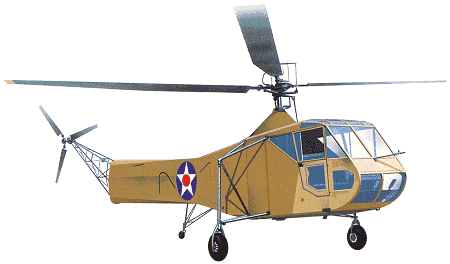
| Sikorsky R-4 1981 |  |
 |

| Sikorsky R-4 1981 |  |
 |
|
The Sikorsky R-4, or VS-316A, was a definitive development of Igor Sikorsky's successful pre-war VS-300, and in 1944 became the first helicopter in the world to be placed in series production. Like the VS-300, it had a framework of heavy-gauge steel tube, and all but the extreme rear end of the fuselage was fabric-covered, as were the 10.97m diameter main rotor blades. A completely new feature was the fully-enclosed cabin, with side-by-side seating and dual controls for the 2-man crew. Powered by a 165hp Warner R-500-3 engine, the prototype VS-316A flew for the first time on 13 January 1942; later, with the military designation XR-4 and serial number 41-18874, the aircraft was handed over to the USAAF for evaluation. It arrived at Wright Field, Ohio, on 18 May 1942, having completed, in stages, the 1225km trip from Bridgeport, Connecticut, in 16 hr. 10 min. flying time. Later in 1942 an order was placed for three service test YR-4A's with 180hp R-550-1 engines and main rotors of 11.58m diameter, and similar changes were made to the XR-4 in 1943, after which it was redesignated XR-4C. Other 1943 developments included the first-ever landing by a helicopter on a ship at sea (the tanker Bunker Hill) and the production of twenty-seven pre-series YR-4B's for further evaluation by the USAAF, the U.S. Navy (three), U.S. Coast Guard (three) and the RAF (seven). These were generally similar to the YR-4A's except for an enlarged cabin, and were used inter alia for winterisation and tropical trials in Alaska and Burma. In the latter theatre one of the YR-4B's carried out the first recorded casualty evacuation operation by helicopter. One hundred production R-4B's were built, similar to the YR-4B except for a more powerful engine; thirty-five were delivered to the USAAF for observation and liaison duties, and twenty to the U.S. Navy as HNS-1 reconnaissance and air/sea rescue aircraft. The remaining forty-five were supplied to Great Britain under Lend-Lease, most of them going to the Royal Navy. The R-4B was known in British service as the Hoverfly I. In the RAF the Hoverfly I replaced the Rota (Cierva C.30A) autogiros of No.529 Squadron from August 1944, and some were supplied to the Helicopter Training School at Andover early in 1945. By the end of the year the type had passed out of RAF service, some aircraft being allocated for radar calibration work with the Telecommunications Research Establishment; others undertook snow and flood reporting duties, and one was allocated to the King's Flight to carry mail and freight. The Joint Experimental Helicopter Unit, established in 1954, was equipped initially with R-4B and R-6A helicopters handed on from the Royal Air Force and Fleet Air Arm. The R-4 did not enjoy a long service career, either in Britain or the United States, being supplanted in the early post-war years by the Sikorsky S-51 and its British-built equivalent, the Westland Dragonfly. Those still in American service were redesignated H-4B in 1948. K.Munson "Helicopters And Other Rotorcraft Since 1907", 1968 
- The first flight of the XR-4 was on 14 January 1942. On 21 April 1945 a single Canadian R-4 became the first helicopter to rescue a downed crew in the Arctic. - Thirty production machines (YR-4As and YR-4Bs) were ordered in total. - US Army Air Force R-4s were used to rescue downed crews in the Pacific. - By the time production switched to the improved R-5/S-51 series, a total of 130 Sikorsky R-4s had been built. - A Sikorsky R-4 was the first true helicopter to make a landing at sea. - On 17 May 1942, the XR-4 flew a distance of 1224km. - Colonel Frank Gregory made the first helicopter landing aboard ship, on 7 May 1943 in Long Island Sound, USA. - Early XR-4s had a metal and fabric-covered fuselage. - The US Navy established its first helicopter squadron, VX-3, at Floyd Bennett Field NAS. - R-4Bs became the first production helicopters in the world.


|